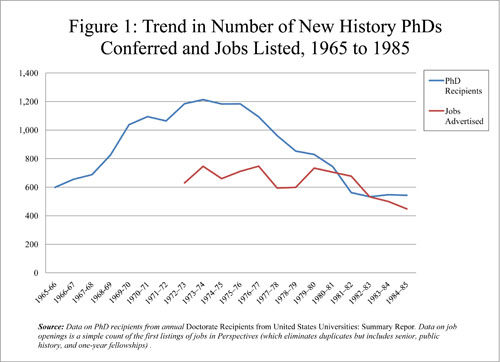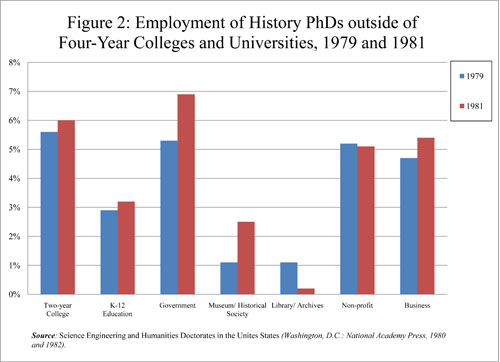Timelines
History in Those Hard Times: Looking for Jobs in the 1970s
Editor’s Note: Continuing our series of essays that cast a backward glance at the AHA’s past, partly in commemoration of its 125th anniversary being celebrated this year, we present below an article that looks at the predicaments faced by historians seeking jobs in the 1970s, and which echoes some of the issues discussed in the essays in this issue by Robert B. Townsend, and John Dichtl and Robert B. Townsend.
While it is little comfort for a doctoral student approaching the history job market now, the present economic problems are not new for the discipline. History faced many of the same issues and debated many of the same solutions 40 years ago.
While the present difficulties are more closely tied to an economic recession, the academic job market in the 1970s suffered from a demographic recession, as a sudden sharp increase in the number of baby boomers receiving history PhDs overran the number of undergraduate students studying history.1 Then, as now, the difficult times were preceded by considerable optimism. From 1960 to 1970, the number of history BAs rose 67 percent, creating significant demand for history teachers at the college level and an encouraging market for prospective graduate students. Tracking these trends, the discipline ramped up the number of new PhD programs (from 80 to 122 between 1960 and 1970) and the number of new PhDs conferred doubled between 1964 and 1970 (from 507 to 1,092).2
However, the interests of undergraduate students shifted to more present-minded concerns in the 1970s, and the number of students receiving BAs in history fell 56 percent, even as the total number of undergraduates at colleges and universities remained fairly constant. Interest in studying history flagged as the disciplinary requirements for teacher certification and graduation were reduced or eliminated at many colleges and universities, and student interest and attention turned to the other social sciences and professional degrees.3
By the time the AHA’s leadership realized the magnitude of the problems confronting them, it was already too late to change the trajectory of many doctoral students’ careers. At the Association’s December 1969 meeting, the number of applicants for jobs at the annual job fair was twice the number of the year before, and almost ten times the number of jobs available.4
The members of the AHA committee on the “professional register”—all senior members of the profession—noted the problem with some equanimity as a “‘time of troubles’ for the fledgling historian.”5 But over the next three years the problems grew significantly worse. A 1970 survey of PhD programs found that less than half of their students seeking employment had found “satisfactory positions” over the previous year. The following year the numbers had become even worse, as 2,481 applicants vied for 188 job openings at the AHA’s annual meeting. The disparity between jobs and PhDs continued to expand throughout the 1970s, as the annual number of new recipients of history doctorates continued at roughly the same pace (around 1,200 new PhDs per year) until the middle of the decade (Figure 1).

For the first few years of the job crisis, efforts to address the employment issues in history were limited by the confining parameters of the profession, which posited that the PhD was a sine qua non for employment as a research scholar (or at the very least a teacher) in academia.6 Within the history discipline, the members and leaders of the AHA spent the first five years of the crisis debating ways to rebalance the two sides of that equation—by either cutting the number of graduate students or increasing the number of available jobs in colleges and universities.
On the supply side, numerous proposals were floated to press schools to cut student admissions and close “less worthy” schools. And on the demand side, as early as the 1971 AHA Business Meeting, resolutions were introduced to encourage older faculty members to “retire at the minimum retirement age,” hire part-time faculty whenever possible, and discourage schools from hiring PhDs who already had full-time employment outside the academy.
But given the average of about eight years from admission to completion of the degree, it took a long time to reduce the number of new students even after doctoral programs began to curtail admissions in 1970. And given that the number of job openings remained relatively stable while the number of PhDs remained at historically high levels, there was very little opportunity for improvement in the number of available positions.
As a result, more than a third of all history PhDs found themselves employed outside of the four-year college and university jobs held up as the ideal by doctoral programs and the AHA. The first reliable federal survey of former doctorate recipients in 1979 found significant numbers of history PhDs widely distributed into a variety of jobs—including two-year and precollegiate teaching positions, as well as positions in government, historical societies, archives, and other nonprofit and for-profit businesses (Figure 2). And the proportions in most categories continued to grow into the early 1980s.

This shift of large numbers of doctorate students into employment outside of academia called into question long-held views about employment of history PhDs. In the mid-1970s the leadership of the AHA tried to more aggressively promote and encourage other job opportunities. The Association attempted to revitalize its engagement with history teaching at all levels, in part by establishing a Teaching Division and a regular column on teaching in the AHA Newsletter to help the profession “respond effectively to history’s changing status in academe.”7
And quite belatedly (given that almost one out of every five history PhDs was finding employment outside of teaching) the AHA also became more attentive to other job areas—highlighting “alternative careers” in both its newsletter and at its annual meeting.
This movement was given a more substantive focus in 1976. Under the direction of Robert Kelly, a program in “public historical studies” was initiated at the University of California at Santa Barbara (intended to “create a new kind of historical person: a public historian”). That same year, the AHA and four other groups established a National Coordinating Committee on the Promotion of Historical Studies and the Employment of Historians to “increase the demand for professional historians, both in the private and public sectors at the local state and national levels.”8
While these efforts helped to ameliorate the sense of crisis, the situation was only fully addressed by a realignment between the number of new PhDs and the number of academic jobs in the 1980s. Although the shape of the historical profession was subtly altered, the normative (and self-fulfilling?) idea that a history PhD is preparation for academic employment was also revived, sowing the seeds for the job crises of the 1990s and of these distressing times.
—Robert Townsend is the AHA’s assistant director for research and publications.
Note
1. This essay is based on research and material in Robert B. Townsend, “Precedents: The History Job Crisis of the 1970s,” Perspectives (April 1997): 9–10 and Robert B. Townsend, “Making History: Scholarship and Professionalization in the Discipline, 1880–1940” (PhD dissertation, George Mason University, 2009).
2. Thomas D. Snyder, Sally A. Dillow, and Charlene M. Hoffman, Digest of Education Statistics, 2008 (Washington, D.C.: National Center for Education Statistics, 2009), Table 317. Available online at http://nces.ed.gov/pubs2009/2009020.pdf.
3. Roger L. Geiger, “Demography and Curriculum: The Humanities in American Higher Education from the 1950s through the 1980s,” in The Humanities and the Dynamics of Inclusion since World War II, ed. David A. Hollinger (Baltimore: Johns Hopkins University Press, 2006), 54–68.
4. The previous year the Washington Post reported that “more than 2,000 young historians were competing for positions at 225 colleges, an increase of 1,000 job seekers since last year’s meeting.” Kim Klein, “Young Historians Find Jobs Scarce,” Washington Post, December 31, 1969, A3. It should be noted, however, that these numbers were not quite as grim as these reports suggest. It was the practice at that time to enter the market well before the dissertation was completed, and a significant number of searches were still conducted through back channels.
5. AHA Annual Report 1969, 130–32.
6. Some critics of the modern languages noted a similar pattern in those disciplines, e.g., Richard Ohmann, “English Departments and the Professional Ethos,” New Literary History 5 (spring 1974): 565–93.
7. Henry Bausum and Myron Marty, “Innovation in Undergraduate History,” AHA Newsletter 12 (September 1974): 3.
8. The NCC, under its first director Arnita Jones, lobbied on behalf of history in Washington and provided a central clearinghouse for information about the emerging public history movement through a regular column in the AHA Newsletter.
Tags: Job Markets
Comment
Please read our commenting and letters policy before submitting.






